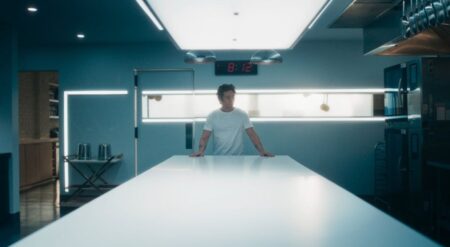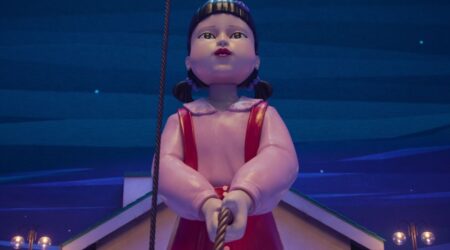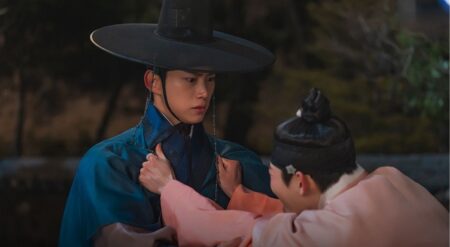Netflix has shown with One Piece that live-action adaptations can be done well, and land as one of the best series of the year. While they will always be in contention with their predecessors, they work best when they honor the material while making updates that are unique to their medium. When they don’t, it can result in a mixed bag at best. Netflix’s Avatar: The Last Airbender is a live-action reimagining of the beloved Nickelodeon animated series originally created by Michael Dante DiMartino and Bryan Konietzko. This iteration of the story, however, comes from Netflix showrunner Albert Kim.
Considered a retelling as opposed to a pure adaptation, the series condenses Book 1 of the original series with some added moments as well. It follows Aang (Gordon Cormier), the last of the Air Nomads, and the Avatar, a master of all four elements. Hunted by the Fire Nation, who seeks to rule the entire world in the twisted name of peace, Aang’s people are erased from history. The only reason he survives is because he was frozen in ice for 100 years. When he emerges from the ice, the brutal Fire Nation has only increases in strength and violence, now led by the Fire Lord Ozai (Daniel Dae Kim).
As Aang processes the new, unfamiliar world and grieves losing everyone he once knew, he meets siblings Sokka (Ian Ousley) and Katara (Kiawentiio). Members of the Southern Water Tribe, the two know just how brutal the Fire Nation can be. Katara is a young waterbender who has hidden her talent out of fear. Sokka is her older brother, a young man trying to become a warrior and protect his sister and the tribe.
The three come together to help Aang learn the other three elements, water, earth, and fire in his quest to bring peace back to the world. All the while, they fight back against the onslaught of the Fire Nation as Crown Prince Zuko (Dallas Liu) hunts them across the land. They’ll need the help of the many allies and colorful characters they meet along the way.
![]()
It must be said that those who have a deep connection to the original animated series will find substantial changes to the characters that go beyond condensing the pacing from 20 episodes into eight. Unfortunately, even when removed from glaring story changes, the series isn’t blowing anyone away on its own merit, mainly because of how the characters are handled.
The glaring issue with the series isn’t production quality or even its lofty pacing. Instead, it’s Katara and the relationships around her. The changes in characters’ ages drastically change the meanings of moments in the series. Sokka wanting to be just a boy doesn’t mean much when he is played by a twenty-something—an observation Yue tells him. The choice hollows out both characters’ importance. And it stands out even more drastically when Katara’s entire role as a character is based on how quickly she had to grow up to take care of Sokka.
Sokka being in the role of a much older brother, instead of only being separated by one year, makes him carry the burden of keeping his family safe. While Sokka feels this push to be the guardian of his family in the original series, it also reveals Katara as the one actually fulfilling that role. Her status as a mother to Sokka also colors how she relates not just to her brother but to Aang as well.
Even when looked at in a vacuum separate from the original series, Katara’s character is reduced to an annoying younger sister. She isn’t strong-willed or guiding. Instead, she feels as if she is being swept along by Aang and Sokka, only to be reprimanded when she strays. Sokka’s identity in the group is more important here. Leaving Katara as yet another teen girl character that has become relegated to a blank slate for the boys around her.
The age disparity is even more visible when we finally get to one of Avatar: The Last Airbender’s iconic moments: The Moon girlfriend. While she is a great actress, 26-year-old Amber Midthunder plays Yue, and the importance of each character coming of age in this world at war is lost. Yue’s sacrifice as a young woman with her full life ahead of her is what makes it all the more impactful. This drives home the issues with Netflix’s Avatar: The Last Airbender. There is knowledge of the source material enough to make one-to-one visual recreations of animation. However, there seems to be a lack of understanding as to why those moments held so much narrative power.
![]()
In an attempt to cater to more adult audiences, the series misses the universal appeal and spark of the original series. Young adult media can be important and loved by adults. Stories deemed for children aren’t void of weight or voice simply because the characters are younger. Netflix misses the emotional weight of your worldviews shattering and being rebuilt with this iteration of Avatar: The Last Airbender. Instead, it privileges spectacle over substance.
But for all of its mishaps with the handling of characters, the Fire Nation men receive a level of depth that allows them to stretch their acting talent. While every character in the ensemble of this series carries trauma and vulnerabilities, the only one who gets to feel that crushing emotional burden is Zuko. The prince is an example of what could have been done for Aang, Katara, and Sokka. Each character has been through tragedy. It has cost them everything they know. But only Zuko and his sacrifice are given the space to maintain its importance and somber tone.
While it can be said that Zuko’s redemption has started too early, the payoff foes work. The complexity of Zuko as a character is that he doesn’t immediately learn kindness. Instead, his experiences in the world with his uncle slowly changed who he was. It’s also through his multiple interactions with Aang and the trio that his redemption begins. Slowly turning from antagonist to a strong lead in the ensemble in Book 3: Fire. That said, the depth of his father’s abuse isn’t skirted around.
Instead of a slow growth, it’s immediately visible that any remote sense of kindness left in this abused kid comes from his Uncle Iroh. Played by Paul Sun-Hyung Lee, Iroh is near perfect, stumbling only when the script chooses exposition over emotion. The tenor of his voice and dedication to bringing compassion to life is visible throughout the entire season. For his part, Lui’s ability to show that Zuko’s vulnerability is always on display is fantastic. Yes, even when he is the brat prince we know from Book 1 of the original series.
Daniel Dae Kim’s performance as Fire Lord Ozai is another standout. Steadfast in his cruelty masquerading as “survival,” Ozai is unwaveringly mean. However, the choice to faithfully adapt some of the regal clothes doesn’t always suit Ozai or the Fire Nation. The costume is grand in scale, but the fabric is one note, lacking the unique ability of live-action to create depth in regal attire, especially when heavily inspired by East Asian royalty. This is also true in the Water Tribe, whose blue coats lack any lived-in quality for a tribe that does a lot of physical labor. Instead, both look too cartoonish for their own good.
![]()
The bending fights are the biggest downfall in the series’ action. There is value in using live-action as a medium to show action. But to show why both versions should exist, the action needs to be just as impactful as the original series. Showing the impact of the elements on the character’s skin and clothes is sorely lacking. The water doesn’t leave characters drenched. Fire doesn’t singe clothes. And the earth doesn’t carry the impact of body and bones.
The lack of weight to the bending action sequences and inconsistent effects work is frustrating. That said, the hand-to-hand action is executed well. The best bending comes from the Agni Kai sequence we see with Zuko and his father, with Katara’s pivotal fight with Pakku (A Martinez) taking second place for the animation of the ice disks alone.
Another positive is the intricacy and beauty brought by the creatures of Avatar: The Last Airbender. Apa and Momo are gorgeously brought to life. Their eyes have soul, and their bodies feel tactile in movement. This expert computer animation is also present in Koh (George Takei). Koh is striking. The creature is something whimsical and terrifying, the latter revealing itself more with each appearance. The thoughtfulness put into these character designs is fantastic in every way.
The large scenery follows up this production high. From the Fire Nation’s boats and balloons to the buildings and beauty of Omashu. The Northern Water Tribe and the Fire Temple all work. That said, the ability to craft fantastic landscapes and a wider world tends to fall flat during smaller moments. When characters are talking, and the camera is panned in, the choice to blur the background makes it all feel like a soundstage. It doesn’t feel like a conversation was had in a real place, and the break-in immersion is jarring.
Avatar: The Last Airbender has small moments worth appreciating, particularly where the Fire Nation is concerned. The production elements of the series are something to be praised in most of the episodes. The ships, the creatures, and anything large and grand feel epic in scale. When the series pans in and gets intimate, it loses its shine. But narratives are built on intimacy and characters, not just wide shots of beautiful landscapes and creature designs. There is undoubtedly room to right the ship in Season 2, but for right now, it’s lost its heart.
Avatar: The Last Airbender is streaming now, exclusively on Netflix.
Avatar: The Last Airbender
-
Rating - 4.5/104.5/10
TL;DR
Avatar: The Last Airbender has small moments worth appreciating…But narratives are built on intimacy and characters, not just wide shots of beautiful landscapes and creature designs.






